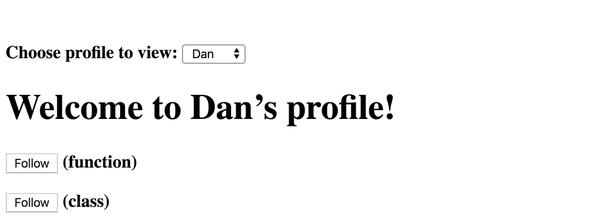本文由 简悦 SimpRead 转码, 原文地址 https://zhuanlan.zhihu.com/p/59558396
- 引言
为什么要了解 Function 写法的组件呢?因为它正在变得越来越重要。
那么 React 中 Function Component 与 Class Component 有何不同?
how-are-function-components-different-from-classes 这篇文章带来了一个独特的视角。
顺带一提,以后会用 Function Component 代替 Stateless Component 的说法,原因是:自从 Hooks 出现,函数式组件功能在不断丰富,函数式组件不再需要强调其无状态特性,因此叫 Function Component 更为恰当。
- 概述
原文事先申明:并没有对 Function 与 Classes 进行优劣对比,而仅仅进行特性对比,所以不接受任何吐槽。
这两种写法没有好坏之分,性能差距也几乎可以忽略,而且 React 会长期支持这两种写法。
Capture props
对比下面两段代码。
Class Component:
1 | class ProfilePage extends React.Component { |
Function Component:
1 | function ProfilePage(props) { |
(在线 Demo)
这两个组件都描述了同一个逻辑:点击按钮 3 秒后 alert 父级传入的用户名。
如下父级组件的调用方式:
1 | <ProfilePageFunction user={this.state.user} /> |
那么当点击按钮后的 3 秒内,父级修改了 this.state.user,弹出的用户名是修改前的还是修改后的呢?
Class Component 展示的是修改后的值:
<img src=”https://pic4.zhimg.com/v2-9d9d77bb138395301509792d9ae9acbf_b.gif“ data-caption=””data-size=”normal”data-rawwidth=”950”data-rawheight=”351”data-thumbnail=”https://pic4.zhimg.com/v2-9d9d77bb138395301509792d9ae9acbf_b.jpg“width=”950”data-original=”https://pic4.zhimg.com/v2-9d9d77bb138395301509792d9ae9acbf_r.jpg“/>
Function Component 展示的是修改前的值:
<img src=”https://pic3.zhimg.com/v2-84396c4b3982827bead96912a947904e_b.gif“ data-caption=””data-size=”normal”data-rawwidth=”901”data-rawheight=”293”data-thumbnail=”https://pic3.zhimg.com/v2-84396c4b3982827bead96912a947904e_b.jpg“width=”901”data-original=”https://pic3.zhimg.com/v2-84396c4b3982827bead96912a947904e_r.jpg“/>
那么 React 文档中描述的 props 不是不可变(Immutable) 数据吗?为啥在运行时还会发生变化呢?
原因在于,虽然 props 不可变,是 this 在 Class Component 中是可变的,因此 this.props 的调用会导致每次都访问最新的 props。
而 Function Component 不存在 this.props 的语法,因此 props 总是不可变的。
为了便于理解,笔者补充一些代码注解:
Function Component:
1 | function ProfilePage(props) { |
Class Component:
1 | class ProfilePage extends React.Component { |
如果希望在 Class Component 捕获瞬时 Props,可以: const props = this.props;,但这样的代码很蹩脚,所以如果希望拿到稳定的 props,使用 Function Component 是更好的选择。
Hooks 也具有 capture value 特性
看下面的代码:
1 | function MessageThread() { |
(在线 Demo)
在点击 Send 按钮后,再次修改输入框的值,3 秒后的输出依然是 点击前输入框的值。这说明 Hooks 同样具有 capture value 的特性。
利用 useRef 可以规避 capture value 特性:
1 | function MessageThread() { |
只要将赋值与取值的对象变成 useRef,而不是 useState,就可以躲过 capture value 特性,在 3 秒后得到最新的值。
这说明了利用 Function Component + Hooks 可以实现 Class Component 做不到的 capture props、capture value,而且 React 官方也推荐 新的代码使用 Hooks 编写。
- 精读
原文 how-are-function-components-different-from-classes 从一个侧面讲述了 Function Component 与 Class Component 的不同点,之所以将 Function Component 与 Class Component 相提并论,几乎都要归功于 Hooks API 的出现,有了 Hooks,Function Component 的能力才得以向 Class Component 看齐。
关于 React Hooks,之前的两篇精读分别有过介绍:
但是,虽然 Hook 已经发布了稳定版本,但周边生态跟进还需要时间(比如 useRouter)、最佳实践整理还需要时间,因此不建议重构老代码。
为了更好的使用 Function Component,建议时常与 Class Component 的功能做对比,方便理解和记忆。
下面整理一些常见的 Function Component 问题:
非常建议完整阅读 React Hooks FAQ。
怎么替代 shouldComponentUpdate
说实话,Function Component 替代 shouldComponentUpdate 的方案并没有 Class Component 优雅,代码是这样的:
1 | const Button = React.memo(props => { |
或者在父级就直接生成一个自带 memo 的子元素:
1 | function Parent({ a, b }) { |
相比之下,Class Component 的写法通常是:
1 | class Button extends React.PureComponent {} |
这样就自带了 shallowEqual 的 shouldComponentUpdate。
怎么替代 componentDidUpdate
由于 useEffect 每次 Render 都会执行,因此需要模拟一个 useUpdate 函数:
1 | const mounting = useRef(true); |
更多可以查看 精读《怎么用 React Hooks 造轮子》
怎么替代 forceUpdate
React 官方文档提供了一种方案:
1 | const [ignored, forceUpdate] = useReducer(x => x + 1, 0); |
每次执行 dispatch 时,只要 state 变化就会触发组件更新。当然 useState 也同样可以模拟:
1 | const useUpdate = () => useState(0)[1]; |
我们知道 useState 下标为 1 的项是用来更新数据的,而且就算数据没有变化,调用了也会刷新组件,所以我们可以把返回一个没有修改数值的 setValue,这样它的功能就仅剩下刷新组件了。
更多可以查看 精读《怎么用 React Hooks 造轮子》
state 拆分过多
useState 目前的一种实践,是将变量名打平,而非像 Class Component 一样写在一个 State 对象里:
1 | class ClassComponent extends React.PureComponent { |
实际上在 Function Component 中也可以聚合管理 State:
1 | function FunctionComponent() { |
只是更新的时候,不再会自动 merge,而需要使用 ...state 语法:
1 | setState(state => ({ ...state, left: e.pageX, top: e.pageY })); |
可以看到,更少的黑魔法,更可预期的结果。
获取上一个 props
虽然不怎么常用,但是毕竟 Class Component 可以通过 componentWillReceiveProps 拿到 previousProps 与 nextProps,对于 Function Component,最好通过自定义 Hooks 方式拿到上一个状态:
1 | function Counter() { |
通过 useEffect 在组件渲染完毕后再执行的特性,再利用 useRef 的可变特性,让 usePrevious 的返回值是 “上一次” Render 时的。
可见,合理运用 useEffect useRef,可以做许多事情,而且封装成 CustomHook 后使用起来仍然很方便。
未来
usePrevious可能成为官方 Hooks 之一。
性能注意事项
useState 函数的参数虽然是初始值,但由于整个函数都是 Render,因此每次初始化都会被调用,如果初始值计算非常消耗时间,建议使用函数传入,这样只会执行一次:
1 | function FunctionComponent(props) { |
useRef不支持这种特性,需要写一些冗余的函判定是否进行过初始化。
掌握了这些,Function Component 使用起来与 Class Component 就几乎没有差别了!
- 总结
Function Component 功能已经可以与 Class Component 媲美了,但目前最佳实践比较零散,官方文档推荐的一些解决思路甚至不比社区第三方库的更好,可以预料到,Class Component 的功能会被五花八门的实现出来,那些没有被收纳进官方的 Hooks 乍看上去可能会眼花缭乱。
总之选择了 Function Component 就同时选择了函数式的好与坏。好处是功能强大,几乎可以模拟出任何想要的功能,坏处是由于可以灵活组合,如果自定义 Hooks 命名和实现不够标准,函数与函数之间对接的沟通成本会更大。
如果你想参与讨论,请 点击这里,每周都有新的主题,周末或周一发布。前端精读 - 帮你筛选靠谱的内容。
关注 前端精读微信公众号
<img src=”https://pic3.zhimg.com/v2-d817340c54185469ec4df17c0938742e_b.jpg“ data-caption=””data-size=”normal”data-rawwidth=”258”data-rawheight=”258”width=”258”/>
special Sponsors
版权声明:自由转载 - 非商用 - 非衍生 - 保持署名(创意共享 3.0 许可证)
写下你的评论…
在线 Demo 挂了~
修复了
class 的这个 bug Dan 好像提过 用 const {XXX} = this.props 可以解决
你在文中好像提了 我没仔细看 不好意思

那么问题来了,为什么要用 hooks…
生命在于不息
我觉得那段 props immutable 解释的是不是有点歧义。。比如,instance 的 this 是可变的,this 在完整的组件声明周期里并不会修改啊,只是 this 上的 props 可能会修改指向。然后。下文用 setTimeout 这段表达的其实是闭包针对变量的捕获吧,这个和是不是 immutable 关系并不大吧 (我觉得这里完全就是闭包的问题)?